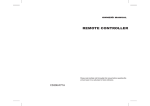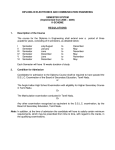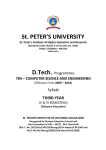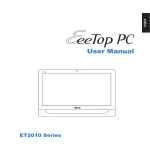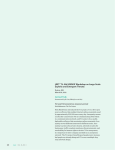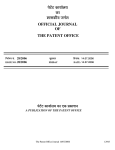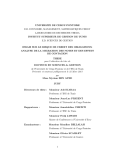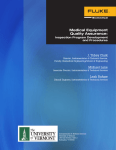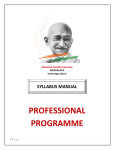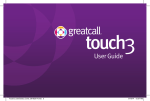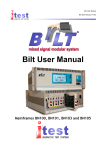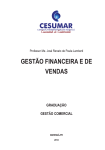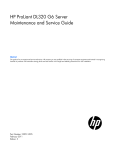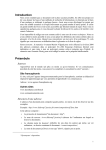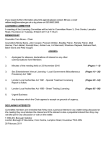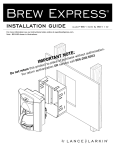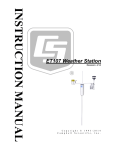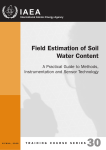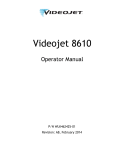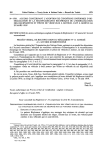Download Syllabus - sunmars.org
Transcript
KARANATAKA STATE OPEN UNIVERSITY DIPLOMA IN COMPUTER ENGINEERING SEMESTER SYSTEM SYLLABUS I YEAR SYLLBUS (Basic Engineering) (Common to all Branches) Subject Subject Title Code Max Marks Max Credits Semester-I BE101 Communication English 100 4 BE102 Applied Mathematics-1 100 4 BE103 Engineering Physics-I 100 4 BE104 Engineering Chemistry-I 100 4 BE105 Computer Application Lab 100 2 BE106 Workshop Practice Lab 100 2 BE201 Applied Mathematics-1I 100 4 BE202 Engineering Physics-II 100 4 BE203 Engineering Chemistry-II 100 4 BE204 Engineering Graphics 100 4 BE205 Physics Lab 100 2 BE206 Chemistry Lab 100 2 Semester -II Computer Engineering III Semester Subject Subject Title Max Marks Max Credits Code CS 301 Operating Systems 100 4 CS 302 C and Data Structures 100 4 CS 303 Basics of Electrical and Electronics 100 4 Engineering CS 304 Microprocessor 100 4 CS 305 C and Data Structures Lab 100 2 CS 306 Basics of Electrical and Electronics 100 2 Max Marks Max Credits Engineering Lab IV Semester Subject Subject Title Code CS 401 Computer Architecture 100 4 CS 402 Web Design 100 4 CS 403 Java Programming 100 4 CS 404 Software Engineering 100 4 CS 405 Java Programming Lab 100 2 CS 406 Web Design Lab 100 2 V Semester Subject Subject Title Max Marks Max Credits 100 4 100 4 Code CS 501 Computer Networks CS 502 Relational Database Management Systems CS 503 Dot Net 100 4 CS 504 Embedded Systems 100 4 CS 505 Networks Lab 100 2 CS 506 Dot Net Lab 100 2 Max Marks Max Credits VI Semester Subject Subject Title Code CS 601 Computer Hardware and Servicing 100 4 CS 602 Mobile Computing 100 4 CS 603 Multimedia 100 4 CS 604 Computer Hardware and Servicing 100 2 400 8 Lab CS 605 Project Total Marks = 3800 Total Credits = 122 SEMESTER :I Subject Code : BE 101 Subject Title : Communication English Structure of the Course Content BLOCK 1 Grammar (Non-Textual) Unit 1: Functional Analysis Unit 2: Voice and parts of speech Unit 3: Direct and indirect speech Unit 4: Preposition BLOCK 2 Grammars Unit 1: One word substitute Unit 2: Articles and question tags Unit 3: Prefixes and suffixes Unit 4: Tenses BLOCK 3 Compositions Unit 1: Comprehension Unit 2: Simple passage Unit 3: Moral story Unit 4: Science and technology BLOCK 4 Letter and dialogue Writing Unit 1: Letter writing - personal Unit 2: Letter writing - official Unit 3: Dialogue writing Unit 4: Hints development BLOCK 5 Proses Unit 1: An Astrloger's day – R.K. Narayanan Unit 2: The sun, the planets and the stars – C.Jones Unit 3: The continuing spell of Ramanujam Unit 4: On saying 'please' – A.G.Gardiner Books: 1. Orient Longman, Anna Salai, Chennai-600002. 2. The Advanced Learners Dictionary of Current English by A.S.Hornby, Oxford University Press. 1973 3. High School English Grammar and Composition by Wren & Martin, S.Chand & Co Ltd., 2005 4. Vocabulary in Practice - Part 1 to 4 by Glennis Pye, Cambridge University Press, 5. Learn Correct English by Shiv K. Kumar & Hemalatha Nagarajan, Pearson Longman, 2005 6. Essential English Grammar by Raymond Murphy,Cambridge University Press, 7. Common Errors in English by M.Thomas, Lotus Press, New Delhi, 2006 8. Basic English Usage by Michael Swan, ELBS/OUP, 1989 9. Communication Skills for Engineers by Mishra ,Ist Edition, Pearson Longman 10. Basic English Dictionary by Longman Longman Ist Edition, Pearson Longman SEMESTER :I Subject Code : BE 102 Subject Title : Applied Mathematics - I Structure of the Course Content BLOCK 1 Algebra Unit 1: Determinants Unit 2: Matrices Unit 3: Permutation and combination Unit 4: Binomial Theorem BLOCK 2 Complex numbers Unit 1: Real and imaginary parts Unit 2: Demoivre's Theorem Unit 3: Finding the n th roots of unity Unit 4: Solving equations BLOCK 3 Analytical geometry Unit 1: Pair of straight lines Unit 2: Circles Unit 3: Family of circles Unit 4: Concentric circles BLOCK 4 Trigonometry Unit 1: Compound angles Unit 2: Multiple angles Unit 3: Sub multiple angles Unit 4: Sum and product formulae BLOCK 5 Differential calculus Unit 1: Limits Unit 2: Differentiation Unit 3: Differentiation methods Unit 4: Successive differentiation Books : 1. Engineering Mathematics by Dr M.K.Venkatraman, National Publishing Co. 2. Engineering Mathematics by Dr P.Kandasamy, S.Chand & Co, New Delhi 3. Higher Engineering Mathematics by Ramana, Tata McGraw Hill, New Delhi 4. Engineering Mathematics by Singh, Tata McGraw Hill, New Delhi 5. Advanced Engineering Mathematics by N.Bali,M.Goyal,C.Watkins,Lakshmi Publications (Pvt) Ltd, New Delhi 6. Engineering Maths by T.Veerarajan, Tata McGraw Hill, New Delhi 7. Schaum's Outline of Technical Mathematics by Paul Calter, Tata McGraw Hill, New Delhi 8. Engineering Mathematics Vol-III by Dr. B. Krishna Gandhi , Dr. T.K.V Iyengar, S.Ranganatham, , S.Chand & Co, New Delhi 9. Introduction to Engineering Mathematics by H.K. Dass, Dr.Rama Verma, S.Chand & Co, New Delhi 10. Applied Engineering Mathematics Vol-II by H.K.Dass, S.Chand & Co SEMESTER :I Subject Code : BE 103 Subject Title : Engineering Physics - I Structure of the Course Content BLOCK 1 S I units and Statics Unit 1: Fundamental quantities Unit 2: Derived quantities Unit 3: Concurrent forces Unit 4: parallelogram Law of forces BLOCK 2 Properties of matter Unit 1: Stress and strain Unit 2: Young's modulus Unit 3: Viscosity Unit 4: Surface Tension BLOCK 3 Dynamics Unit 1: Projectile Motion Unit 2: Angle of projection Unit 3: Circular Motion Unit 4: Application of circular motion BLOCK 4 Rotational motions of rigidity bodies Unit 1: Moment of Inertia Unit 2: Kinetic energy Unit 3: Angular Momentum Unit 4: Kepler's Law BLOCK 5 Remote sensing and sound Unit 1: Active and Passive remote sensing Unit 2: Microwave remote sensing Unit 3: Types of sound waves Unit 4: Acoustics Books : 1. Physics by Resnick and Hoilday ,Wisley Toppan Publishers – England 2. Mechanics by Narayana Kurup , S. Chand Publishers – New Delhi 3. Engineering Physics by B.L. Theraja , S. Chand Publishers – New Delhi 4. Remote sensing by Dr.M.Anji Reddy, Jawaharlal Nehru Technological University –Hyderabad. 5. Engineering Physics by V.Rajendran, Tata McGraw Hill, New Delhi 6. Engineering Physics by Vikram Yadav, Tata McGraw Hill, New Delhi 7. Schaum's Outline of Physics for Engineering and Science by Michael Browne, Tata McGraw Hill, New Delhi 8. Modern Engineering Physics by A.S.Vasudeva, S. Chand Publishers, New Delhi 9.Engineering Physics Fundamentals & Modern Applications by P.Khare and A.Swarup, Lakshmi Publications (Pvt) Ltd, New Delhi 10. Engineering Physics by Dipak Chandra Ghosh,Nipesh Chandra Ghosh,Prabir Kumar Haldar, Lakshmi Publications (Pvt) Ltd, New Delhi SEMESTER :I Subject Code : BE 104 Subject Title : Applied Chemistry - I Structure of the Course Content BLOCK 1 Acids – Bases, Catalysis Unit 1: Theories of Acids and Bases Unit 2: Industrial application Unit 3: Positive and Negative catalyst Unit 4: Characteristics of Catalyst BLOCK 2 Pollution Unit 1: Air Pollution Unit 2: Global warming Unit 3: Water Pollution Unit 4: Green Chemistry BLOCK 3 Electro chemistry and corrosion Unit 1: Types of conductors Unit 2: Industrial applications of Electrochemistry Unit 3: Electrochemical theory Unit 4: Electroplating BLOCK 4 Organic coatings Unit 1: Paint Unit 2: Varnish Unit 3: Adhesives Unit 4: Lubricants BLOCK 5 Colloids and Ceramics Unit 1: Colloidal solution Unit 2: Brownian movement Unit 3: Water purification Unit 4: Ceramics Books : 1. Inorganic chemistry by Soni PL, Sultan Chand &sons. 2. Organic chemistry by Soni PL, Sultan Chand & sons. 3. Engineering chemistry by Jain & Jain, Dhanpat rai &co 4. Engineering chemistry by Uppal , Khanna publishers 5. Environmental chemistry &Pollution control by Dara .SS, S. Chand&co 6. Environmental Pollution by . Tripathy .SN , Sunakar panda - Vrinda publication 7. Rain water Harvesting-hand book by Chennai Metro Water 8. Introduction to Engineering Chemistry by Minaxi B Lohani, Upma Misra, S.Chand & Co, New Delhi 9. Engineering Chemistry by Dr.A.K.Pahari,Dr.B.S.Chauhan, Lakshmi Publications (Pvt) Ltd, New Delhi 10. Advanced Engineering Chemistry by M.Senapati, Lakshmi Publications (Pvt) Ltd, New Delhi SEMESTER Subject Code Subject Title :I : BE 105 : Computer Application Lab Practicals Windows 1.a. Starting a program, running a program. b. Starting the Windows in safe mode c. Running multiple Programs and switching between windows. d. Moving the windows, and the task bar. e. Startup to MS-DOS prompt. 2.a. Creating and removing a folder. b. Making the taskbar wider, arranging icons on the Desktop. c. Displaying and hiding the taskbar clock. d. Controlling the size of start menu options. e. Creating shortcuts. 3.a. Installing a screen saver. b. Assigning Wallpaper to Desktop. c. Adding a program to the start menu. d. Recovering files and folders from Recycle bin. e. Customizing the mouse settings. 4 a. Expanding and collapsing a folder. b. Recognizing file types using icons. c. Running a program from explorer. d. Renaming a file or folder. e. Selecting two or more files for an operation. 5.a. Displaying the properties for a file or folder. b. Using cut and paste operations to copy a file. c. Using copy and paste operations to copy a file. d. Moving and copying files with mouse. e. Sorting a folder. 6.a. Finding a file or folder, by name. b. Defragmenting the disk using disk defragmenter. c. Compressing a file using WinZip. d. Controlling the speaker volume. e. Recording and saving an audio file. MS Word a. Prepare a newsletter with borders, two columns text, header and footer and a graphic image and spell check the document. b. Create a table to show the paradigm of the verb “eat” in all 12 tenses c. Prepare your Bio-data/Resume d. Do the mail merge operation for sending applications to many companies with your resume MS EXCEL 1.Create a worksheet in Excel for a company: a. Copy, Move and Merge the cells b. Adding Comments c.Adding, Deleting the cells, Rows and Columns d. Hiding and Unhiding the columns, Rows and gridlines. 2.Using formula and functions prepare worksheet for storing subject marks of ten students and perform the following: a. Calculate the student wise total and average b. Calculate the subject wise total and average c. Calculate the overall percentage and also individual percentage of the student. 3. Create Bar Graph and Pie Chart for various data MS Power Point a. Create a simple presentation with atleast 5 slides to introduce your friend and include sounds in slides. b. Create a presentation with 5 slides for the essay Astrologer’s Day by R.K Narayanan Internet a. Creating an E-Mail account. b. Sending an E-Mail to a known Address c. Viewing an E-Mail received from your friend/relative. d. Printing an E-Mail received e. Use of Attachment Facility f. Use of Address Book Facility g. Use of Sent Folder h. Use of Save Draft Folder i. Use of Trash Folder j. Browse a given web-site address. k.Search a Particular topic through a Search engine. SEMESTER Subject Code Subject Title :I : BE 106 : Workshop Practice Fitting 1. Fitting 2. V - Joint 3. L - Joint 4. T - Joint 5. Half round joint 6. Dovetail Joint 7. U – Joint 8. Hexagonal – Joint 9. Step - Joint 10.Drilling and Tapping M8 11.Drilling and Tapping M10 Wiring 1. Single lamp controlled by single switch. 2. Two Lamps controlled by Two independent switches. 3. Stair case Wiring 4. Fluorescent lamp circuit. 5. Circuit diagram of a fan 6. Circuit diagram of an iron box 7. Circuit diagram of a mixie 8. Soldering practice Sheet Metal 1. Hemming 2. Seaming 3. Tray 4. Cylinder 5. Cone 6. Hopper 7. Dust Pan 8. Funnel SEMESTER : II Subject Code : BE 201 Subject Title : Applied Mathematics - II Structure of the Course Content BLOCK 1 Vector Algebra Unit 1: Introduction Unit 2: Vector Properties Unit 3: Product of Vectors Unit 4: Application of Vectors BLOCK 2 Integral Calculus Unit 1: Integration Unit 2: Standard Integrals Unit 3: Integration by parts Unit 4: Bernoulli’s Theorem and Applications BLOCK 3 Differentiation Unit 1: Velocity and Acceleration Unit 2: Tangents and Normals Unit 3: Maxima and Minima Unit 4: Partial differentiation BLOCK 4 Application of Integration Unit 1: Definite Integral. Unit 2: Area and Volume Unit 3: Solution of differential equations Unit 4: Second order differential equation with constant coefficients BLOCK 5 Probability Distributions Unit 1: Continuous random variable Unit 2: Discrete random variable Unit 3: Discrete Distributions (Binomial, Poisson ) Unit 4: Continuous Distribution Books : 1. Engineering Mathematics by Dr M.K.Venkatraman, National Publishing Co. 2. Engineering Mathematics by Dr P.Kandasamy, S.Chand & Co, New Delhi 3. Higher Engineering Mathematics by Ramana, Tata McGraw Hill, New Delhi 4. Engineering Mathematics by Singh, Tata McGraw Hill, New Delhi 5. Advanced Engineering Mathematics by N.Bali,M.Goyal,C.Watkins,Lakshmi Publications (Pvt) Ltd, New Delhi 6. Engineering Maths by T.Veerarajan, Tata McGraw Hill, New Delhi 7. Schaum's Outline of Technical Mathematics by Paul Calter, Tata McGraw Hill, New Delhi 8. Engineering Mathematics Vol-III by Dr. B. Krishna Gandhi , Dr. T.K.V Iyengar, S.Ranganatham, , S.Chand & Co, New Delhi 9. Introduction to Engineering Mathematics by H.K. Dass, Dr.Rama Verma, S.Chand & Co, New Delhi 10. Applied Engineering Mathematics Vol-II by H.K.Dass, S.Chand & Co SEMESTER : II Subject Code : BE 202 Subject Title : Engineering Physics - II Structure of the Course Content BLOCK 1 Heat Unit 1: Heat - Kinetic Theory of Gases: Unit 2: Specific Heat Unit 3: Isothermal Changes Unit 4: Adiabatic Changes BLOCK 2 Gases & Non Conversional Energy Unit 1: Liquefaction of Gases Unit 2: Joule Thomson Effect & Linde’s process Unit 3: Renewable and Non-renewable sources Unit 4: Alternate sources of Energy- BLOCK 3 Light & Magnetism Unit 1: Optical Instruments Unit 2: Lasers Unit 3: Basic definitions of Magnetism Unit 4: Hysteresis Loop BLOCK 4 Electricity Unit 1: Basic laws Unit 2: Force on a moving charge Unit 3: Measuring Instruments Unit 4: Heating Effect of Electric Current BLOCK 5 Dielectric effect & Electronics Unit 1: Chemical Effect of Electric Current Unit 2: Capacitor Unit 3: Semiconductors , PN Junction & Transistors Unit 4: Logic Gates Books : 1. Physics by Resnick and Hoilday ,Wisley Toppan Publishers – England 2. Mechanics by Narayana Kurup , S. Chand Publishers – New Delhi 3. Engineering Physics by B.L. Theraja , S. Chand Publishers – New Delhi 4. Remote sensing by Dr.M.Anji Reddy, Jawaharlal Nehru Technological University –Hyderabad. 5. Engineering Physics by V.Rajendran, Tata McGraw Hill, New Delhi 6. Engineering Physics by Vikram Yadav, Tata McGraw Hill, New Delhi 7. Schaum's Outline of Physics for Engineering and Science by Michael Browne, Tata McGraw Hill, New Delhi 8. Modern Engineering Physics by A.S.Vasudeva, S. Chand Publishers, New Delhi 9.Engineering Physics Fundamentals & Modern Applications by P.Khare and A.Swarup, Lakshmi Publications (Pvt) Ltd, New Delhi 10. Engineering Physics by Dipak Chandra Ghosh,Nipesh Chandra Ghosh,Prabir Kumar Haldar, Lakshmi Publications (Pvt) Ltd, New Delhi SEMESTER : II Subject Code : BE 203 Subject Title : Applied Chemistry - II Structure of the Course Content BLOCK 1 Nuclear Chemistry Unit 1: Unit 2: Unit 3: Unit 4: BLOCK 2 Radio activity and definitions Half life period & Nuclear fission & fusion Applications of radio active isotopes Abrasives Fuels and Refractory’s Unit 1: Fuels - classification Unit 2: Solid and Liquid Fuels Unit 3: Gas Fuels Unit 4: Refractory’s BLOCK 3 Water Treatment Unit 1: Water Treatment Methods Unit 2: EDTA Method Unit 3: Water -purification Unit 4: Lime and manufacturing process BLOCK 4 Plastics and Rubber Unit 1: Thermoplastics, Unit 2: Thermo set plastics Unit 3: Natural rubberUnit 4: Synthetic rubber BLOCK 5 Metallurgy Unit 1: Tungsten &Titanium Unit 2: Powder metallurgy Unit 3: Purpose of alloying Unit 4: Non ferrous alloys Books : 1. Inorganic chemistry by Soni PL, Sultan Chand &sons. 2. Organic chemistry by Soni PL, Sultan Chand & sons. 3. Engineering chemistry by Jain & Jain, Dhanpat rai &co 4. Engineering chemistry by Uppal , Khanna publishers 5. Environmental chemistry &Pollution control by Dara .SS, S. Chand&co 6. Environmental Pollution by . Tripathy .SN , Sunakar panda - Vrinda publication 7. Rain water Harvesting-hand book by Chennai Metro Water 8. Introduction to Engineering Chemistry by Minaxi B Lohani, Upma Misra, S.Chand & Co, New Delhi 9. Engineering Chemistry by Dr.A.K.Pahari,Dr.B.S.Chauhan, Lakshmi Publications (Pvt) Ltd, New Delhi 10. Advanced Engineering Chemistry by M.Senapati, Lakshmi Publications (Pvt) Ltd, New Delhi SEMESTER : II Subject Code : BE 204 Subject Title : Engineering Graphics Structure of the Course Content BLOCK 1 Drawing Office Practice Unit 1: Basics of Engg Drawing Unit 2: Dimensioning Unit 3: Scales Unit 4: Geometrical Constructions, conics and geometrical curves BLOCK 2 Projection Unit 1: Orthographic Projection Unit 2: Projection of simple solids Unit 3: Section of Solids Unit 4: Half & Full Sectioning BLOCK 3 Pictorial drawings Unit 1: Introduction Unit 2: Isometric Drawings Unit 3: Conversion of orthographic views BLOCK 4 Development of Surfaces: Unit 1: Cube, Cylinder Unit 2: Prism Unit 3: Pyramids Unit 4: Tee and Elbow BLOCK 5 AutoCAD Unit 1: Introduction Unit 2: AutoCAD commands Unit 3: Drawing -line, circle, arc, polygon, Unit 4: Drawing - ellipse, rectangle Books : 1. Engineering Drawing by Gopalakrishnan.K.R., (Vol.I and Vol.II), Dhanalakshmi publishers, Edition 2, 1970 2. First Year Engineering Drawing by Barkinson & Sinha, Pitman Publishers, London, Edition 3, 1961 3. A Book on AutoCAD Release 2007. 4. Engineering Drawing by Shah/Rana,Ist Edition Pearson Longman 5. Machine Drawing with AutoCAD by Pohit/Ghosh, Ist Edition Pearson Longman 6. Engineering Graphics by Prof.P.J.Shah, S.Chand & Co, New Delhi 7. Computer Graphics including CAD,AUTOCAD &C by A.M.Kuthe, S.Chand & Co, New Delhi 8. Engineering Graphics by Dhawan R.K, S.Chand & Co, New Delhi 9. Auto CAD 2005 for Engineers by Ionel Simon, Lakshmi Publications (Pvt) Ltd, New Delhi 10. Engineering Drawing by Agrawal, Tata McGraw Hill, New Delhi Drawing Practices SEMESTER : II Subject Code : BE 205 Subject Title : Engineering Physics Lab List of Experiments 1 VERNIER CALIPERS - To find the volumes of the solid cylinder and hollow cylinder using vernier callipers. 2 SCREW GAUGE – To find the thickness of (a) glass plate (b) given sphere using screw gauge. Hence calculate the volume of the glass plate and the sphere. 3 SIMPLE PENDULUM – To find the acceleration due to gravity in the laboratory, using simple pendulum. Calculate the acceleration due to gravity, by L–T2 graph. 4 CONCURRENT FORCES -To verify the parallelogram law of forces and Lami’s theorem. 5 COPLANAR – PARALLEL FORCES – To verify the conditions of the Co-planar parallel forces. 6 TORSION PENDULUM – To find the rigidity modulus of the thin wire and moment of inertia of the disc by using symmetric masses. 7 COMPARISON OF VISCOSITIES – To compare the coefficient of viscosities of two liquids by capillary flow method. 8 VISCOSITY OF A HIGHLY VISCOUS LIQUID – To find the coefficient of viscosity of a highly viscous liquid. 9 SURFACE TENSION: To find the surface tension of the given liquid by capillary rise method 10 YOUNG’S MODULUS – To find the young’s modulus of the material of the given metre scale. 11 SPECTROMETER – 1. To find the angle of the prism. 12 SPECTROMETER – 2. To find the refractive index of the material of the prism. 13 DEFLECTION MAGNETOMETER – To compare the magnetic moments of two given magnets by (a) Equal distance method and (b) Null method. 14 SONO METER – To find the frequency of the given tuning fork. 15 JOULE’S CALORIMETER – To determine the specific heat capacity of the given liquid. 16 COPPER VOLTAMETER – To determine electro – chemical – equivalent of copper. 17 OHM’S LAW – To determine the resistance of two given coils of wire using Ohm’s law. Also verify the laws of resistances. 18 POTENTIO METER – To compare the e.m.fs of two given cells. 19 PN JUNCTION DIODE – For the given semiconductor diode draw (a) Forward bias (b) Reverse bias characteristic curves. 20 SOLAR CELLS – V. I. Characteristics. SEMESTER : II Subject Code : BE 206 Subject Title : Applied Chemistry Lab List of Experiments 1.Qualitative Analysis Acid radicals : Chloride, Carbonate, Sulphate, Nitrate Basic radicals: Lead, Cadmium, Copper, Aluminium, Zinc, Calcium, Magnesium, Ammonium Identification of acid and basic radicals in 1. Lime Stone (Calcium Carbonate) 2. Pollutant (Lead nitrate or Cadmium Carbonate) 3. Fertilizer(Ammonium sulphate) 4. Electrolyte(Ammonium Chloride) 5. Fungicide(Copper sulphate) 6. Coagulant(Aluminium Sulphate) 7. Mordant(Zinc Sulphate) 8. Gypsum(Calcium Sulphate) 9. Epsum(Magnesium Sulphate) 10. Analysis of an Effluent (containing pollutants like Lead, Cadmium, Zinc, Copper).Students may be given above four pollutants , in four separate test tubes in solution form and asked to report metallic pollutants with procedure (Basic Radical Analysis Procedure) and their harmful effects. 2. VOLUMETRIC ANALYSIS (DOUBLE TITRATIONS) ACIDIMETRYAND ALKALIMETRY 1. Estimation of Hydrochloric acid 2. Estimation of Sodium Hydroxide 3. Estimation of Sodium Carbonate 4. Comparison of Strengths of two bases PERMANGANIMETRY 5. Estimation of Ferrous Ammonium Sulphate 6. Estimation of Ferrous Sulphate 7. Comparison of Potassium Permanganate. WATER ANALYSIS 8. Estimation of Total Hardness by EDTA method. 9. Calculation of pH of four sample solutions and calculation of H+ Ion concentration for a particular sample solution. Subject Code : CS301 Subject Title : Operating System Structure of the Course Content BLOCK 1 OVERVIEW OF OPERATING SYSTEMS AND PROCESSES Unit 1: Introduction Unit 2: Types of OS Unit 3: Process Unit 4: Process Scheduling BLOCK 2 INTERPROCESS COMMUNICATIONS & SYNCHRONIZATION Unit 1: Introduction Unit 2: Inter process Communication Unit 3: Semaphores Unit 4: Deadlocks BLOCK 3 MEMORY MANAGEMENT Unit 1: Introduction Unit 2: Paging Unit 3: Segmentation Unit 4: Virtual Memory BLOCK 4 I/O AND FILE MANAGEMENT Unit 1: I/O Management Unit 2: File Management Unit 3: Secondary Storage Management Unit 4: Disk Scheduling BLOCK 5 LINUX PROGRAMMING AND ADMINISTRATION Unit 1: Introduction Unit 2: Linux Commands and Utilities Unit 3: Shell Scripts Unit 4: System Administration Books : 1. Operating System by William Stallings, Prentice Hall of India, 4th Edition, 2003. 2. Operating System Concepts by Abraham Silberschatz, and James L. Addision Wesley Publishing Company 3. Operating Systems – A Concept Based Approach by D.M. Dhamdhere, TMGH 4. Operating Systems , Concepts and Design by Milan Milenkovie, TMGH, 2000 5. Linux - The Complete Reference by Richard Peterson, Tata McGraw Hill, New Delhi 6. Operating Systems – Design and Implementation by Andrew S. Tanenbaum, Prentice Hall of India, New Delhi 7. Introduction to Operating Systems by Harvey M. Deital, Addision Wesley Publishing Company 8.Operating Systems and Software Diagnostics by Ramesh Bangia, Balvir Singh, Lakshmi Publications (Pvt) Ltd, New Delhi 9.Operating Systems Concepts by P.S.Gill, Lakshmi Publications (Pvt) Ltd, New Delhi 10. Operating Systems Fundamentals by D.Irtegov, Lakshmi Publications (Pvt) Ltd, New Delhi Subject Code : CS302 Subject Title : C and Data Structures Structure of the Course Content BLOCK 1 ASIC ELEMENTS OF “C” and CONTROL STATEMENTS Unit 1: Keywords, Constants, Variables and Data types Unit 2: Operators and Expressions Unit 3: Control Statements Unit 4: Programs using Operators and Control structures Unit 5 : Cement BLOCK 2 ARRAYS, STRINGS, and FUNCTIONS Unit 1: Arrays Unit 2: Strings Unit 3: Functions Unit 4: Programs using arrays, functions BLOCK 3 STRUCTURES AND UNIONS and POINTERS Unit 1: Structures and Unions Unit 2: Pointers Unit 3: Relation of pointers with other elements Unit 4: Dynamic memory allocation Unit 5: Programs using Structures, Unions and Pointers BLOCK 4 LINEAR DATA STRUCTURES Unit 1: Elementary data organization Unit 2: Linked Lists Unit 3: Stacks Unit 4: Queues BLOCK 5 NON LINEAR DATA STRUCTURES Unit 1: Trees Unit 2: Graphs Unit 3: Searching Unit 4: Sorting Books : 1. Programming in ANSI C by E. Balagurusamy TMGH, New Delhi 2. Programming with C by Byron Gottfried. Schaum Series -TMGH 3. Let us C by Yashavent Kanethar BPB Publication, 2005, New Delhi 4. Programming in C by Schaum Series, McGraw Hills Publishers 5. Data Structures by Lipschutz Schaum Series 6. Introduction to Data structures by Bhagat Singh, TMGH, New Delhi 7. Introduction to Data structures with applications by Trembley and Sorenson, TMGH 8. Data Structure using ‘C’ by Dr.Prabhakar Gupta, Vineet Agarwal,Manish Varshney, Lakshmi Publications (Pvt) Ltd, New Delhi 9. Data Structure using ‘C++’ by N.Jayalakshmi, Lakshmi Publications (Pvt) Ltd, New Delhi 10. Introduction to Data Structure using C by Venkatesh N.Baitipuli, Lakshmi Publications (Pvt) Ltd, New Delhi Subject Code Subject Title : CS303 : BASICS OF ELECTRICAL & ELECTRONICS ENGINEERING Structure of the Course Content BLOCK 1 DC AND AC FUNDAMENTALS Unit 1: DC Circuits Unit 2: AC Fundamentals Unit 3: Batteries Unit 4: Safety measures BLOCK 2 ELECTRICAL MACHINES Unit 1: DC generator Unit 2: DC Motors Unit 3: Single phase transformer Unit 4: AC Motors - Induction motor BLOCK 3 ANALOG DEVICES Unit 1: Semi conductor theory Unit 2: Rectifiers Unit 3: Special Diodes Unit 4: Transistor BLOCK 4 BOOLEAN ALGEBRA AND LOGIC GATES Unit 1: Number representation Unit 2: Logic gates Unit 3: Logic Simplification Unit 4: Arithmetic circuits BLOCK 5 COMBINATIONAL and SEQUENTIAL LOGIC SYSTEMS Unit 1: Multiplexer - De multiplexer Unit 2: Flip flops Unit 3: Counters Unit 4: Registers Books : 1 Electrical Technology by B.L. Theraja S.Chand and Co, New Delhi 2 Principles of Electrical Engineering by B.R. Gupta S.Chand and Co, New Delhi 3. Digital Principles & Applications by Albert P.Malvino & Donald P.Leach McGraw-Hill 4. Principles of Electronics by V.K.Metha S.Chand & Co. 5. Electronic Devices and Circuits –An introduction by Allen Mottershed, Prentice-Hall of India 6. Digital Electronics Principles and Applications by Tokheim, Tata McGraw-Hill 7. Digital Electronics by R.P. Jain, TMH, New Delhi 8. Electronics Engineering by Ashish Dixit, Anand Chopra, , Lakshmi Publications (Pvt) Ltd, New Delhi 9. Basic Electronics Engineering & Devices by Dr.R.K.Singh, Ashish Dixit, Lakshmi Publications (Pvt) Ltd, New Delhi 10. Electrical and Electronics Engineering by Vikramaditya Dave, Lakshmi Publications (Pvt) Ltd, New Delhi Subject Code : CS304 Subject Title : Microprocessor Structure of the Course Content BLOCK 1 Introduction Unit 1: Evolution of Microprocessors Unit 2: Advantages of Microprocessors Unit 3: Various MPU Families (SSI, LSI, VLSI, SLSI) BLOCK 2 8085 Unit 1: Introduction Unit 2: Architecture of 8085 Unit 3: Block and Pin Diagram of 80851 and it’s functions Unit 4: BUS Details BLOCK 3 8085 Programming Unit 1: Instruction formats & Addressing Modes Unit 2: Instruction Set and It’s Cycle Unit 3: Timing Diagrams and Status Signals Unit 4: Simple Programs BLOCK 4 8085 Interfacing Unit 1: Memory mapping Unit 2: Interrupts Unit 3: I/O Peripheral Interfacing BLOCK 5 16 bit Microprocessor Unit 1: Introduction to 8086 Unit 2: Architecture of 8086 Unit 3: Block and Pin Diagram of 8086 and it’s functions Unit 4: BUS Details Books: 1. 8085 Microprocessor and its applications by Ramesh gaonkar, Penram Publishers 2. 8086 Microprocessor by Douglas hall 3. Advanced Microprocessor and Microcontrollers by N.Parasuraman, N.V.Publications 4. www.Intel.com 5. Microprocessors and Interfacing by Douglas V.Hall and Hebber,K.M, Tata McGraw-Hill 6. Advanced Microprocessors & Peripherals by Dr. Ajoy Kumar Ray and K.M.Burchandi, Tata McGraw-Hill 7. Advanced Microprocessors and Interfacing by Badri Ram, Tata McGraw-Hill 8. Introduction to Microprocessors by A.P.Mathur, Tata McGraw-Hill Microprocessor 8085 by G.T.Swamy, Lakshmi Publications (Pvt) Ltd, New Delhi 9. Advanced Microprocessor and Microcontrollers byProf S.K.Venkata Ram, Lakshmi Publications (Pvt) Ltd, New Delhi 10. VLIW Microprocessor Hardware Design by lee Weng Fook, Tata McGraw-Hill Subject Code Subject Title : CS305 : C AND DATA STRUCTURES LABORATORY Structure of the Course Content 1. a). Write a program to convert the given temperature in degree centigrade to Fahrenheit and vice versa. b) Write a program to find the simple and compound interest for the amount (P) at the rate of interest (R) for the year N. c) Write a program to enter two numbers from the user and prints the sum, product, difference, and quotient of the two numbers. 2. a). Write a program to identify whether a number input from the keyboard is even or odd. If it is even, the program should display the message “Number is even”, else it should display “Number is odd”. (Using if-else) 3. a). Write a program to find out whether a given number is a perfect number. The program should terminate if a negative integer is given as the input. A perfect number is a number whose factors other than itself add up to itself. Example: 6 = 1 + 2 + 3, 28 = 1 + 2 + 4 + 7 + 14 b) Develop a simple calculator to accept two floating point numbers from the keyboard. Then display a menu to the user and let him/her select a mathematical operation to be performed on those two numbers. Then display the answer. A sample run of you program should be similar to the following: ( Using switch statement) 4. a). Write a program to compute the sum of all integers between any given two numbers. b) Write a program to find and print the first 10 terms of the Fibonacci sequence. Assume the first two terms are 0 and 1. c) Write a program to count the number of positive numbers, number of negative numbers and number of zeros in the given N elements. 5. a). Write a program to calculate and display the total and the average of 10 integer numbers. b) Read 3 subject marks of 4 students. Write a program to calculate and display the total marks of each student. Use a 2D (two-dimensional) array to store the marks 6. a). Devise a function called min (x , y) that returns the smaller of two double values. Test the function with a simple data. b) Write a function to find the biggest number in a given array using function. c) Write a program to find the factorial of a given number using recursion. 7. a). Write a C program to find the number of vowels present in the string. [Assume your string contains both uppercase and lowercase characters] b) Write a program to find whether a given string is palindrome or not. c) Read a string, which consists of both lower case characters and upper case characters. Convert the lowercase character into upper case and vice versa. Display the new string. 8. a). Write a program for nested structure, the two structures are declared within a single structure. The two inner structures are : “dob” ( fields : dd, mm, yy) and “address” ( st, cty) and the outer structure “Student” ( fields : rollno, name). Write a main program to get and display the details of N students. b) Write a Program to print the student name, rollno, marks using unions. 9. a). Write a program to swap two integer numbers using pointers. b) Read a string. Print the above string such that each line contains a single character. ( Use pointers) c) Read an integer array consists of N elements. Print the elements in reverse order 37 using pointers. 10. a). Write a C program to read through an array of any type using pointers. Write a C program to scan through this array to find a particular value b) Using pointers, find the length of the string. c) Write a “C” program to concatenate two strings using pointers. 11. a). Write a C program to create a singly linked list . Make necessary assumptions. b) Write a C program to delete the first node that contains an integer data item of a single linked list. 12. Write a “C” program to perform operations in stack using array. 13. Write a “C” program to convert an infix expression into post fix expression. 14. Write a “C” program to evaluate a postfix expression. 15. Write a “C” program to perform operations in queue using array. 16. Write a “C” program to create a binary tree. 17. Write a “C” program for pre -order traversal of a binary tree. 18. Write a “C” Program for binary searching. 19. Write a “C” program to read 10 elements and sort the above numbers using bubble sort. 20. Write a “C” program to read 10 elements and sort the above numbers using quick sort. Subject Code Subject Title : CS306 : ELECTRICAL AND ELECTRONICS LABORATORY Structure of the Course Content 1. Test the value of the resistance by using (i) Analog and Digital multimeter (ii) Color coding with and without tolerance value. 2. a) Measure current, voltage and resistance using Various test meters – Ammeter, Voltmeter and multi meter. b) Generate AC and DC signals using signal generator and power supply. 3. Verify Ohm’s law and Kirchoff’s law. 4. Draw the forward bias characteristics of a PN Junction diode and determine the forward resistance of the diode. 5. Draw the reverse bias characteristics of a Zener diode. 6. Draw the characteristics of Common Emitter Configuration and determine its input impedance, output impedance and current gain. 7. Construct and test half - wave and full - wave rectifier circuits. 8. Verify truth tables of logic gates using IC 7404, 7408, 7432, 7402, 7400 and 7486. 9. Realize the logic gates using Universal gates. 10. Realize the circuit to simplify the logic equation by using karnaugh map. 11. Verify De-Morgan’s Theorems. 12. Construct Half adder and full adder circuits using ICs and verify their truth table. 13. Construct Half subtractor and full subtractor circuits using ICs and verify their truth table. 14. Verify the operation of a multiplexer and de-multiplexer using IC’s 15. Implement and Test RS, JK, T and D flip-flops. 16. Construct and test 4-bit ripple counter and observe the output waveform. 17 Construct and test 4-bit shift registers. Subject Code : CS401 Subject Title : Computer Architecture Structure of the Course Content BLOCK 1 REGISTER TRANSFER LOGIC Unit 1: Register transfer language Unit 2: bus and memory transfer Unit 3: Arithmetic micro operations Unit 4: Logic micro operations Unit 5: Shift micro operations BLOCK 2 CPU Unit 1: Major components of CPU Unit 2: general register organization Unit 3: Parallel Processing Unit 4: Control Unit BLOCK 3 INPUT- OUTPUT SYSTEM Unit 1: I/ O interface Unit 2: Modes of transfer Unit 3: I/O Programming Unit 4: IOP communications BLOCK 4 MEMORY ORGANISATION Unit 1: Types of Memory Unit 2: Associative memory Unit 3: Cache memory Unit 4: Virtual memory BLOCK 5 PC ARCHITECTURE Unit 1: Block diagram of 8086 Unit 2: Registers Unit 3: Address Unit 4: Basic Instructions Books : 1. Computer System Architecture by Morris Mano.M., Prentice Hall of India 2. Computer Organisation and Architecture by William Stallings Prentice Hall of India, 2002 3. Assembly language and Programming by Peter Abel, Prentice Hall of India 4. Fundamentals of Assembly Language Programming Using IBM PC by Detmer Richard.C, Galgotia Publications Ltd. NewDelhi 5.Computer Architecture (SIE) (Schaum’s Outline Series) by Carter, Tata McGraw-Hill 6. Computer Architecture and Organisation: Design Principles and Applications by Govindarajulu, Tata McGraw-Hill 7. Advanced Computer Architecture by Hwang, Tata McGraw-Hill 8. computer Organisation by ISRD Group, Tata McGraw-Hill 9. Computer System Organisation by Jotwani, Tata McGraw-Hill 10. Introduction to Computer Architecture by S.Sridhar,N.V.Publication Subject Code : CS402 Subject Title : Web designing Structure of the Course Content BLOCK 1 INTERNET CONCEPTS Unit 1: Definition of Internet – History of Internet Unit 2: Internet Protocols Unit 3: Internet Applications Unit 4: Application Protocols BLOCK 2 HTML Unit 1: Introduction to HTML Unit 2: Basic Tags of HTML Unit 3: Special Characters - Working with Images Unit 4: Link, List & Table Tags Unit 5: Frames & Graphical Components BLOCK 3 CLIENT SIDE SCRIPTING Unit 1: JavaScript Basics Unit 2: Object-Based Programming and Message boxes Unit 3: JavaScript with HTML Unit 4: Using JavaScript URLs BLOCK 4 SERVER SIDE SCRIPTING Unit 1: Client side scripting versus Server Side scripting Unit 2: JSP Elements Unit 3: Implicit objects Unit 4: Writing Simple JSP programs BLOCK 5 XML and CSS Unit 1: Browsing and parsing XML Unit 2: XML components Unit 3: DTD Unit 4: CSS Books : 1. Internet and Web Design by Ramesh Bangia, Firewall Media 2. Web Design by Jenkins, Wiley India 3. HTML and Web designing by Kris Jama and Konrad King, Tata McGraw Hill Publishing Ltd 4. Using HTML 4, XML and Java 1.2 by Eric Ladd and Jin O’Donwell, Prentice Hall of India,New Delhi 5. Web Technology and Design by C. Xavier, New Age International Publishers, New Delhi 6. Java Server Pages by Ivan Bayross, Shroff publishers &Distributors Pvt Ltd, Delhi 7. Teach yourself web Technologies by Ivon Bayross, BPB publications – 2002 8. Web programming by Chris Bates, Wiley – Dreamtech India Pvt Ltd 9. Web Technology A Developers Perspective by N.P. Goplan J.Akilandeswari, New Age International Publishers, New Delhi 10. Web Technology by Ramesh Bangia, Lakshmi Publications (Pvt) Ltd, New Delhi Subject Code : CS403 Subject Title : Java Programming Structure of the Course Content BLOCK 1 INTRODUCTION TO OOPS AND JAVA Unit 1: Introduction to Oops: Unit 2: History Java Unit 3: Types of java program Unit 4: Elements BLOCK 2 CONTROL STRUCTURES, ARRAYS, VECTORS & STRINGS Unit 1: Decision making Unit 2: Branching Unit 3: Arrays Unit 4: Strings BLOCK 3 CLASSES, INTERFACES AND PACKAGES Unit 1: Class Unit 2: objects Unit 3: Inheritance Unit 4: Packages BLOCK 4 APPLETS, AWT CONTROLS AND EXCEPTION HANDLING Unit 1: Applets Unit 2: AWT Components Unit 3: Even Handlers Unit 4: Exception Handling BLOCK 5 MULTITHREADS, STREAMS, and NETWORKING & DATABASE Unit 1: Multithreading Unit 2: I/O Streams Unit 3: Networking Unit 4: JDBC Books : 1, Programming with Java by E. Balagurusamy, Tata McGraw-Hill Publishers , II Edition 2.Java – The Complete Reference by Herbert Schildt, Tata McGraw-Hill Publishers , V Edition 3.Java for you by Koparkar, TMH 4.Java Programming Language by Ken Arnold , James Gosling, Addison Wesley 5.Introducing to Oops with Java by C Thomas WU. – 4th Edition, Tata Mc-Graw Hill 6. Internet and Java Programming by Harish Kumar Taluja, Lakshmi Publications (Pvt) Ltd, New Delhi 7. Programming Engineering Computations in Java by Dr.Raja Subramanian, Lakshmi Publications (Pvt) Ltd, New Delhi 8. Simply Java:An Introduction to Java Programming by James R.Levenick, Lakshmi Publications (Pvt) Ltd, New Delhi 9. Java: J2SE 5-A Practical Approach by B.Mohamed Ibrahim, Lakshmi Publications (Pvt) Ltd, New Delhi 10. Advance Java by Gajendra Gupta, Lakshmi Publications (Pvt) Ltd, New Delhi Subject Code : CS404 Subject Title : Software Engineering Structure of the Course Content BLOCK 1 INTRODUCTION TO SOFTWARE ENGINEERING Unit 1: Basics of Software Engineering Unit 2: Software Development Life cycle Unit 3: Software Development Life Cycle Models Unit 4: Software Requirement Analysis BLOCK 2 SOFTWARE DESIGN AND PLANNING Unit 1: Software Design Unit 2: Software Planning Unit 3: COCOMO Model Unit 4: CASE BLOCK 3 SOFTWARE MAINTENANCE AND RISK MANAGEMENT Unit 1: Software Maintenance Unit 2: Software configuration management activities Unit 3: Risk management Unit 4: Project scheduling BLOCK 4 SOFTWARE TESTING Unit 1: Software Testing Unit 2: Levels of testing Unit 3: Software Testing strategies Unit 4: Testing Tools BLOCK 5 SOFTWARE RELIABILITY AND QUALITY ASSURANCE Unit 1: Software Quality Assurance Unit 2: CMM - Five levels - ISO 9000 Unit 3: Software Reliability Unit 4: Reverse Software Engineering Books : 1 Software Engineering by Ian Sommerville, Pearson Education 2 Software Engineering – A practioner’s Approach by Roger S. Pressman, McGraw-Hill 3. Software Engineering by Sajan Mathew, S. Chand & Company Ltd 4. Integrated approach to Software Engineering by Pankaj Jalote, Narosa Publishing House, 2004 5. Software Engineering fundamentals by Ali Behforooz and Fredick J Hudson, Oxford University press,2005 6. Software Testing techniques by Bories Beizer, Dream Tech Press,2004 7.Software Engineering by Bharat Bhushan Agarwal, Sumit Prakash Tayal, Lakshmi Publications (Pvt) Ltd, New Delhi 8. Human Aspects of Software Engineering byJames E.Tomayko, Orit Hazzan, Lakshmi Publications (Pvt) Ltd, New Delhi 9. System Software by M.Joseph , Lakshmi Publications (Pvt) Ltd, New Delhi 10. The Software Vulnerability Guide by Herbert H. Thompson, Scoot G.Chase, Lakshmi Publications (Pvt) Ltd, New Delhi Subject Code Subject Title : CS405 : Java Programming Lab Structure of the Course Content 1. a). Write a Program to find the area of a rectangle. b) Write a program to find the result of following expressions (Assume a = 10, b = 5) i) (a << 2) + (b >>2) ii) (a) || ( b>0) iii) ( a + b * 100) /10 iv) a & b 2. a). Write a program that asks the user to enter two integers, obtains the numbers from the user, and then prints the larger number followed by the words "is larger." If the numbers are equal, print the message “These numbers are equal.” b) Write a program that reads an integer and determines and prints whether it is odd or even. 3. a). Write a program to find the sum of the digits of a given number. b) Write a program to find the first 15 terms of the Fibonacci sequence. 4. a). Write a program to read N numbers and find the largest and smallest numbers. b) Write a program for the multiplication of two matrices. 5.Write a program that accepts a shopping list of four items from the command line and stores them in a vector. Write a Menu based Program to perform the following operations using vector a. To add an item at a specific location in the list. b. To delete an item in the list. c. To print the contents of the vector. d. To delete all elements e. To add an item at the end of the vector 6. a) Write a program in Java to create a String object. Initialize this object with your name. Find the length of your name using the appropriate String method. Find whether the character ‘a’ is in your name or not; if yes find the number of times ‘a’ appears in your name. Print locations of occurrences of ‘a’. b) Create a String Buffer object and illustrate how to append characters. Display the capacity and length of the string buffer. 7. a). Write a program to display total marks of 5 students using student class. Given the following attributes: Regno(int), Name(string), Marks in subjects(Integer Array), Total (int). b) Write a program in Java with class Rectangle with the data fields width, length, area and colour. The length, width and area are of double type and colour is of string type. The methods are get_length(), get_width(), get_colour() and find_area(). 8. Create a class to represent complex numbers. A complex number has the form real part + i * imaginary part. Provide constructor to enable an object of this class to be initialized when it is declared. Provide a no-argument constructor with default value in case no initializes are provided. Provide public methods for the following i) Addition of two complex numbers ii) Subtraction of two complex numbers iii) Printing complex numbers in the form (a,b) where a is the real part and b is the imaginary part 9. a). Write a program to show how a class implements two interfaces. b) Show through a program that fields in an interface are implicitly static and final and methods are automatically public. 10. Write a program to create a package for Book details giving Book Name, Author Name, Price, year of publishing. 11. A color can be created by specifying the red, green, blue values as integer parameters to the constructor of class Color. The values range from 0 to 255. Provide three horizontal scroll bars and ask the user to select the values of the colors by dragging the thumb in the scroll bar. Using the color selected, draw a rectangle. 13. Create an applet for simple calculator to perform Addition, Subtraction, Multiplication and Division using Button, label and Text field classes. 14. Draw a bar chart for the following details using Applets. 15. Write a Java program to catch more than two exceptions. 16. Write a Java program for producer and consumer problem using Thread. 17. Write a program to transfer the file between client and server using TCP/IP 18. a) Write a program to create a text file using Byte stream classes b) Write a program to copy a file to another file. 19. Write a Java Program to connect to a database created in MS-ACCESS using JDBC Concept. Perform basic operations of Selection, Insertion and deletion on the database. Subject Code : CS406 Subject Title : Web Design Lab Structure of the Course Content 1. Design a HTML page describing your profile in one paragraph. Design in such a way that it has a heading, a horizontal rule, three links and your photo. Also, write three HTML documents for the links. Include facilities for forward, backward and HOME. 2. Design a HTML page about your friends. List your friends. Each friend’s name is a link. Prepare separate HTML documents for each friend and call them in the appropriate link. 3. Design a single page website for your polytechnic containing a description of the courses offered. It should also contain some general information about the university such as its history, the campus, its unique features and so on. The site should be colored and each section should have a different color. 4. Make out a brief bio-data of yours and code it as an HTML page. You can consider using tables to show your academic history. 5. Write a Java script code to validate the username and password. The username and password are stored in variables. 6. Write a Java Script code using frames and Events (When a cursor moves over an object it should display the specification of the object in another frame) 7. Create a site containing banner ads at the top of the page. The ads are changed every 10 or 15 seconds. 8.Collect the definitions of 10 items in chemistry. These definitions are stored in two string arrays name[] and defn[]. Write a JSP which has these two arrays and supplies the definition on request. Write a HTML document which gets the user input of the name of the item and sends the request to the JSP. 9. Write a JSP code to manipulate cookies. 10. Write a JSP code to upload data from client side. 11. Create a JSP application using image map to give information about the institution. 12. Write a program to create the chatting application using Application and Session object. 13. Write a program to check whether a person will be permitted to open a particular page or not. Use permission checker component. 14 Write a program for incorporating entities in to XML document using an internal DTD. 15. Write a program using CSS to create a time table for the class. 16. Write a program using CSS to set the background colors, fonts and paragraphs. Subject Code : CS501 Subject Title : Computer Networks Structure of the Course Content BLOCK 1 DATA COMMUNICATIONS Unit 1: Components of a data communication Unit 2: Types of Networks Unit 3: Signals and Modulation Unit 4: Transmission Media Unit 5: Network devices BLOCK 2 OSI MODEL AND DATA LINK LAYER Unit 1: Network Models Unit 2: Error detection & correction Unit 3: Flow and Error control Unit 4: Flow control protocols BLOCK 3 LAN PROTOCOLS Unit 1: Character oriented Protocol Unit 2: 802.X Protocols Unit 3: FDDI Unit 4: Switching Unit 5: ISDN BLOCK 4 TCP/IP SUIT Unit 1: Overview of TCP / IP Unit 2: Network Layers Protocol Unit 3: IP Addressing Unit 4: Application Layer Protocols BLOCK 5 INTRODUCTIONS TO NETWORK SECURITY Unit 1: Introduction to network security Unit 2: Types of attacks Unit 3: Hacker Techniques Unit 4: Threats & Firewall Books : 1 Data Communication and networking by Behrouz A.Forouzan Tata McGraw-Hill, 2. Computer Communication Networks by Achyut S. Godbole Tata McGraw-Hill 3. Data and Computer Communications by William Stallings, Prentice-Hall of India 4. Computer Networks by Andrew S.Tanenbaum, Prentice-Hall of India,New Delhi 5. Network Security a beginner’s Guide by Eric Maiwald, Tata Mc Graw-Hill. 6. TCP/IP Protocol Suite by Foruzan, Tata Mc Graw-Hill 7. Communication Networks by Kasera,Sumit, Tata Mc Graw-Hill 8.Computer Network by Rachna Sharma, Lakshmi Publications (Pvt) Ltd, New Delhi 9. Introduction to Computer Network by Madhulika Bhatia,Madhurima Bhatia, Lakshmi Publications (Pvt) Ltd, New Delhi 10.Data and Computer Communication by Rachna Sharma, Lakshmi Publications (Pvt) Ltd, New Delhi Subject Code : CS502 Subject Title : Relational Database Management Systems Structure of the Course Content BLOCK 1 BASIC CONCEPTS OF DBMS Unit 1: Database terms Unit 2: Components of a DBMS Unit 3: Data abstraction Unit 4: DBMS system architecture types: BLOCK 2 RELATIONAL DATABASE APPROACH Unit 1: Relational data structure Unit 2: Table Unit 3: E-R model & Normalization Unit 4: Normalization BLOCK 3 STRUCTURED QUERY LANGUAGE Unit 1: Data Definition Language Unit 2: SQL Commands Unit 3: Functions and Operators Unit 4: Transaction control statements BLOCK 4 PL/SQL Unit 1: Control statements Unit 2: Cursors Unit 3: Exceptions Unit 4: PL/SQL tables and records BLOCK 5 ENHANCED DATABASE MODELS Unit 1: Characteristics, functioning and architecture of Data Warehousing Unit 2: data modeling Unit 3: Data Clustering Unit 4: Applications of Data mining problem Books : 1. Database Management System by Date ,C.J., Galgotia Publications 2. Fundamentals of Database System by Elmasri, R.A.,Navathe, Shyam B. Narosa Publishing House. 3. Database Management System by Post, Gerald V, Tata McGraw-Hill, 2004 4. An introduction to Database Systems by Bipin C Desai, Galgotia Publications ( P) Ltd., 2005 5. Database system concepts by Abraham Silberschatz,Henry F Korth and Sudharshan S, Mc Graw Hill Publishing Company Limited, 2004 6. Database Management Systems by Raghu Ramakrishnan, Mc Graw Hill Publishing Company Limited, 2004 7.Fundamentals of Data base management Systems by Leon, Tata McGraw-Hill 8.Introduction to Data base management Systems by ISRD Group, Tata McGraw-Hill 9. Data base management Systems by POST, Mc Graw Hill Publishing Company Limited 10.DBA Study Guide: OCP Prep Guide by Lakshmi Publications (Pvt) Ltd, New Delhi Subject Code : CS503 Subject Title : Dot Net Structure of the Course Content BLOCK 1 INTRODUCTION TO .NET FRAMEWORK Unit 1: Managed Code and the CLR Unit 2: Automatic Memory Management Unit 3: Language Concepts and the CLR Unit 4: The Framework Class Library BLOCK 2 INTRODUCTIONS TO VISUAL BASIC.NET Unit 1: Elements Unit 2: Types Unit 3: Windows programming Unit 4: Menus and Dialog Boxes BLOCK 3 APPLICATION DEVELOPMENT USING ADO .NET Unit 1: Architecture of ADO.NET Unit 2: Command Unit 3: Accessing Data Unit 4: Create an ADO.NET application BLOCK 4 INTRODUCING ASP.NET Unit 1: ASP.NET Features Unit 2: Creating Web Controls Unit 3: Creating Web Forms Unit 4: Adding ASP.NET Code to a Page. BLOCK 5 XML WEB SERVICES Unit 1: XML Serialization in the .NET Framework Unit 2: web services protocol and standards Unit 3: UDDI Unit 4: Web Service by Using Visual Studio .NET. Books : 1. Introduction to Visual basic.NET by NIIT Prentice Hall of India,2005 2. Introducing Microsoft .NET by David S. Platt Microsoft Press”, Saarc Edition, 2001 3. Introduction to Microsoft® ASP.NET Work Book by Microsoft Microsoft Press 4. Developing XML Web Services Using Microsoft® ASP.NET by Microsoft, Microsoft Press 5. Designing Microsoft ASP.NET Applications by Douglas J. Reilly, Microsoft Press 6. ASP.NET by Danny Ryan and Tommy Ryan, Hungry Minds Maran Graphics 7. www.microsoft.com 8. Dot Net by Kumaran S, N.V.Publications Subject Code : CS504 Subject Title : Embedded Systems Structure of the Course Content BLOCK 1 PIC INTRODUCTION Unit 1: Architecture of PIC controller Unit 2: Memory Organization Unit 3: Bus architecture Unit 4: Basic Instruction set BLOCK 2 PIC 167877 CPU Unit 1: Basic Programming in PIC 16F877 Unit 2: Port Programming Unit 3: Timer Programming Unit 4: Serial Port Programming Unit 5: Interfacing (Switch, LCD, Relay, Memory, etc) BLOCK 3 ARM INTRODUCTIONS Unit 1: ARM Architecture Unit 2: Memory & Bus Interfacing Unit 3: Addressing Signal & Timing Unit 4: ARM7TDMI Core and System state BLOCK 4 LPC2148ARM CPU Unit 1: Architectural overview Unit 2: Memory mapping Unit 3: Port Programming Unit 4: Timer & Serial Port Programming BLOCK 5 OPERATING SYSTEMS OVERVIEW Unit 1: Functions of OS Unit 2: Introduction to Kernel Unit 3: Task & Scheduling Unit 4: µC / OS - II Books : 1. Data Sheet for PIC Controller 2. Embedded System Architecture by Tammy Noergaard 3. ARM System Developer’s Guide by Andrew N. Sloss 4. ARM Architecture Reference Manual by David Seal 5. ARM System-on-chip Architecture by Steve Furbe ( Second Edition) 6. MicroC / OS – II The Real Time Kernel by Jean J. Labrosse 7. Real Time Concepts for Embedded Systems by Qing Li and Caroline Yao 8. Embedded / Real Time Systems: Concepts, Design & Programming by Dr. K.V.K.K. Prasad 9. LPC2148 User Manual 10. Embedded Systems: Architecture, Programming and Design by Raj Kamal, Tata McGraw-Hill Subject Code Subject Title : CS505 : Networks Lab Structure of the Course Content 1. Do the following Cabling works in a network a) Cable Crimping b) Standard Cabling and c) Cross Cabling 2. Establish a LAN connection using three systems using bus topology. 3. Establish Peer to Peer network connection using two systems in a LAN 4. Interface PCs using connectivity devices – Hub, router and switch. 5. a) Configure IP Address in a system in LAN (TCP/IP Configuration) b) Configure DNS to establish interconnection between systems 6. a) Transfer files between systems in LAN using FTP Configuration b) Login a system remotely using telnet protocol. 7. a) Install and configure Network interface card in LAN system b) Share a file and printer (remotely) between two system in a LAN 8. Establish security in a system using firewall configuration 9. Create and share the user rights by accessing server for a specific user groups 10. Install and configure the following a) A DHCP server in windows with IP Address ranging from 192.168.1.1 to 192.168.1.100 b) Configure a DHCP Client 11. Transfer Files between wireless Communication. 12. Configure Mail server The Following programs to be written in ‘C’ 13. Write a program that takes a Binary file as input and finds error check using different mechanism. 14. Write a Client program to download a file from HTTP server. 15. Write a program to Simulate Sliding Window Protocol Subject Code : CS506 Subject Title : Dot Net Lab Structure of the Course Content 1. Accept a character from console and check the case of the character. 2. Write a program to accept any character from keyboard and display whether it is vowel or not. 3. Wrtie a VB.Net program to accept a string and convert the case of the characters. 4. Develop a menu based VB.Net application to implement a text editor with cut, copy, paste, save and close operations. 5. Write a program to implement a calculator with memory and recall operations. 6. Develop a Form in VB.NET to pick a date from Calendar control and display the day, month, year details in seperate text boxes. 7. Develop a VB.Net application to perform timer based quiz of 10 questions. 8. Develop a VB.Net application using the File, Direcory and Directory controls to implement a common dialog box. 9. Develop a database application to store the details of students using ADO.NET 10 Develop a database application using ADO.NET to insert,modify, update and delete operations. 11 Develop a VB.Net application using Datagrid to display records. 12 Develop a VB.Net application using Datagrid to add, edit and modify records. ASP.NET 13. Create a simple ASP.NET page to Output Text with a form, two HTML text boxes, an HTML button, and an HTML <span> element. Create an event procedure for the button. 14.. Create a web controls to a page with three different controls to the ASP.NET page for reserving rooms in hotel. The three controls are a button control, a label control, and a drop-down list control. 15. Create a application for Accessing a SQL Database by Using ADO.NET by connecting to the SQL Server database and call a stored procedure. You then display the data in a Repeater control. 16. Create a web services application for calling a Web service for a hotel named full. And you will call another Web service for a hotel named Empty, and then retrieve information regarding room availability. The Web service for the Full hotel is named Hotel_Full.dll. The Web service for the Empty hotel is named Hotel_Empty.dll. There are five methods in each service. Subject Code : CS601 Subject Title : Computer Hardware and Servicing Structure of the Course Content BLOCK 1 INSIDE THE PC Unit 1: Evolution of Computer Unit 2: Mother Board & Chipsets Unit 3: Bus Standards & Bios-setup Unit 4: Processors BLOCK 2 MEMORY AND DAUGHTER BOARDS Unit 1: Memory Unit 2: Graphic Cards Unit 3: Sound Cards Unit 4: Displays & Display adapter Unit 5: Keyboard, and Mouse and barcode scanner BLOCK 3 DISK DRIVES Unit 1: Hard Disk Unit 2: CD/DVD ROM Unit 3: Special type of drives Unit 4: I/O Ports BLOCK 4 I/O DEVICES AND POWER SUPPLY Unit 1: Printers Unit 2: Scanners Unit 3: Web Camera, Biometric devices Unit 4: SMPS BLOCK 5 TROUBLE SHOOTING PC Unit 1: Room Preparation and Power supply Unit 2: Installation practice Unit 3: Faults elimination process Unit 4: Diagnostic Software and Viruses Books : 1. IBM PC and CLONES by B.Govindrajalu, Tata McGraw-Hill Publishers 2. Computer Installation and Servicing by D.Balasubramanian, Tata McGraw Hill , 2005 3. Computer Installation and Troubleshooting by M.Radhakrishnan, ISTE- Learning Materials 2001 4. The complete PC upgrade and Maintenance by Mark Minasi, BPB Publication 5. Inside the PC by Peter Norton, Tech Media 6. Troubleshooting, Maintaining and Repairing PCs by Stephen J Bigelow, Tata MCGraw Hill Pub 2001 7. Basic Refrigeration and Air-Conditioning by Ananthanrayanan P.N, Tata McGraw-Hill 8.PC hardware by Balvir Singh, Lakshmi Publications (Pvt) Ltd, New Delhi 9.PC Repair and Maintenance:A Practical Guide by Joel Rosenthal,Kevin Irvin, Lakshmi Publications (Pvt) Ltd, New Delhi 10.PC Architecture and Peripherals-I by Dinesh Maidasani, Lakshmi Publications (Pvt) Ltd, New Delhi Subject Code : CS602 Subject Title : Mobile Computing Structure of the Course Content BLOCK 1 WIRELESS COMMUNICATION FUNDAMENTALS Unit 1: History of cellular mobile communication Unit 2: Multiplexing Unit 3: Medium Access Control Unit 4: Telecommunication Systems and Cellular Wireless Networks BLOCK 2 WIRELESS LOCAL AREA NETWORK Unit 1: Definition – Advantages and Disadvantages of LAN Unit 2: WLAN technologies Unit 3: IEEE 802.11 Unit 4: HIPERLAN BLOCK 3 BLUETOOTH TECHNOLOGY Unit 1: Bluetooth Radio Unit 2: Bluetooth Protocol Architecture Unit 3: Bluetooth Security Unit 4: Comparison of wireless LAN and Bluetooth technology. BLOCK 4 MOBILE NETWORK LAYER Unit 1: Mobile IP Unit 2: Dynamic Host Configuration protocol Unit 3: Routing Unit 4: Transport Layer BLOCK 5 WIRELESS APPLICATION PROTOCOL Unit 1: WAP components Unit 2: WAP client & network architecture Unit 3: WAP Programming model Unit 4: WAP 2.0 additional services. Books : 1. Mobile Communications by Jochen Schiller Pearson Education, New Delhi. 2. Wireless Communication of Networks by William Stallings PHI 3. BlueTooth Demystified by Nathan J.Muller, Tata McGraw – Hill Publication, New Delhi 4. Mobile Cellular telecommunications: Analog and Digital Systems by Lee, Tata McGraw Hill Publication 5. Mobile Communication Engineering by Lee, Tata McGraw Hill Publication 6. Wireless Communication Networks by Misra, Tata McGraw Hill Publication 7. Wireless Communications by Signal, Tata McGraw Hill Publication 8. Mobile Ado Networks by Aggelou, Tata McGraw Hill Publication 9. 2.5G Mobile Networks by Kasera, Tata McGraw Hill Publication 10. Communication Networks by Kasera, Sumit, Tata McGraw Hill Publication Subject Code : CS603 Subject Title : Multimedia Structure of the Course Content BLOCK 1 INTRODUCTION TO MULTIMEDIA Unit 1: Definitions - History of Multimedia; Unit 2: Image Unit 3: Product Unit 4: Evolution BLOCK 2 MULTIMEDIA HARDWARE AND SOFTWARE Unit 1: Hardware Unit 2: Basic Software Tools Unit 3: Making instant Multimedia Unit 4: Multimedia authoring tools BLOCK 3 MULTIMEDIA BUILDING BLOCKS Unit 1: Text Unit 2: Sound Unit 3: Images Unit 4: Video BLOCK 4 MULTIMEDIA AND THE INTERNET Unit 1: Internet Services Unit 2: Multimedia on the Web Unit 3: Tools for the World Wide Web Unit 4: Designing for the World Wide Web BLOCK 5 DESIGNING OF PROJECTS Unit 1: Multimedia File Handling Unit 2: Multimedia Development Team Unit 3: Graphic artist Unit 4: Multimedia development process Books: 1. Multimedia making it work by Tay Vaughan, Tata McGraw-Hill, Delhi 2. Multimedia – Technology and applications by David Hillman, Galgotia Publications, Delhi 3.Multimedia Technologies by Banerji, Tata McGraw-Hill 4. Principles of Multimedia by Parekh, Tata McGraw-Hill 5. Computer Graphics by ISRD Group, Tata McGraw-Hill 6.Multimedia Applications and Web Designing by Dinesh Maidasani, Lakshmi Publications (Pvt) Ltd, New Delhi 7. Multimedia Basics- Technology(Vol.I) by Andreas Holzinger, Lakshmi Publications (Pvt) Ltd, New Delhi 8. Multimedia Basics- Learning (Vol.II) by Andreas Holzinger, Lakshmi Publications (Pvt) Ltd, New Delhi 9. Multimedia Basics- Design (Vol.III) by Andreas Holzinger, Lakshmi Publications (Pvt) Ltd, New Delhi Subject Code : CS604 Subject Title : Computer Hardware and Servicing Lab Structure of the Course Content 1. Identification of System Layout: a.) Front panel indicators and switches b.) Front side and rear side connectors 2. Familiarize the computer system Layout : Making positions of SMPS, Motherboard, FDD, HDD, CD, DVD and add on cards. 3. BIOS set up: Configuring bios setup program and practicing the trouble shooting of typical problems using BIOS utility. 4. a.) Install Hard Disk, b.) Configure CMOS-Setup c.) Partition HDD using FDISK,d.) Format Hard Disk. e.) Master /Slave / IDE Devices. 5.. a.) Install and Configure a CD-Writer and a DVD writer. b.) Recording a Blank CD and DVD. 6. Printer Installation and Servicing: a.) Head Cleaning b.) Install and configure Dot matrix printer and Laser printer c.) Troubleshoot the above printers. d.) Check and connect the data cable connectivity 7. Modem and TV Tuner card Installation: a.) Install and configure Internal and External Modem b.) Install and Configure TV tuner card. 8. a.) NIC, Router Installation b.) Installing NIC, router and Modem for XP / Linux environment. c.) Configuring using device drivers d.) Diagnosis and trouble shooting. 9. a.) Install audio/video devices,microphone, speaker and head set and Digital camera. b.) Trouble shoot the audio-video devices. 10. a.) Install and configure Scanner . Trouble shoot the problems.. b.) Install and configure Web cam. 11. a.) Identify the problems in Pentium System with add on Cards. b.) Identify problems with software installation using drivers available in the motherboard CD. 12. Practice with scan disk, disk cleanup, disk De-fragmenter, Virus Detecting and Rectifying Software 13. Practice with back up and restoring data in a network server using external storage Device 14. Assemble a Pentium (II/III/IV) system with add on cards and check the working condition of the system. 15. Windows XP- Operating system Installation. 16. Install and Set up Dish connection to system. 17. Identify the connectors using wireless devices. 18. Interfacing the cell phone with system. Subject Code Subject Title : CS605 : Project
















































